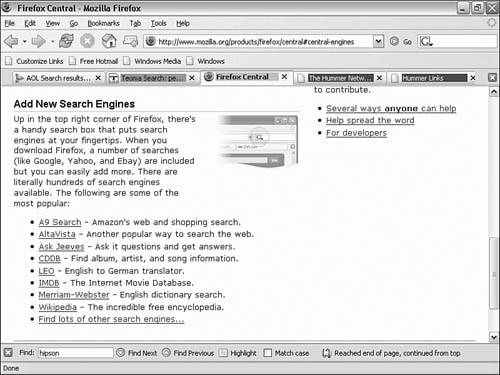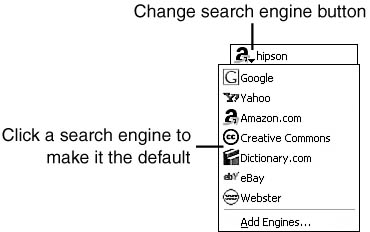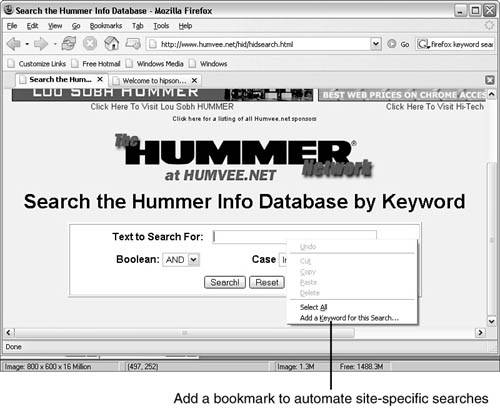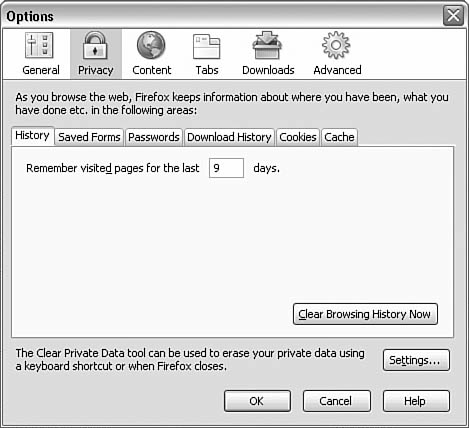IN THIS CHAPTER
In this chapter we will work with Firefox’s search and find components. The World Wide Web is vast and complex with literally billions of web pages to choose from, but sophisticated search engines such as Google are making it easier to organize and find content of interest.
The following is a listing of popular search engines. For each of these sites, I did a search for my name (Peter Hipson):
Google (http://www.google.com)—. Google is a search engine that is very effective and easy to use. Unlike some search engines, Google doesn’t offer a lot of fluff such as advertising, news, and such; instead it has a simple user interface that allows for searches—and that’s about all. Google is supported mostly by paid advertising, which is presented with the search results. My name search returned just over 800 hits.
Yahoo! (http://www.yahoo.com)—. Using Yahoo! opens a wide vista of features and functionalities. This site provides searching and more. With Yahoo!, you’ll sees news, advertising, email, and many other features that Yahoo! hopes adds value to the user experience and promotes return usage. My name search returned about 1,700 hits.
MSN (http://www.msn.com)—. Microsoft created an online service called MSN (Microsoft Network) as a precursor to its foray into the world of the Internet. As strange as it seems, Microsoft almost missed the Internet boat, only jumping onboard at the last minute! MSN offers news and many other services that make it a favorite home page for many Internet users. MSN’s search-only URL is at http://search.msn.com. My name search returned just under 5,000 hits.
AOL (http://www.aol.com)—. It seems that people either love or hate AOL. I tried an AOL search and got…only about 50 pages of hits. My name search didn’t even find my own website in the first page! AOL’s search is linked to Google.
Excite Network (http://www.excite.com)—. Excite looks a lot like other multifunctionality search sites, in that it offers news, sports, and other features. My name search returned only 72 hits.
AskJeeves (http://www.ask.com)—. Like Google, Ask Jeeves is primarily a search site and provides little other material. My name search returned more than 3,900 matches.
InfoSpace (http://www.infospace.com)—. InfoSpace specializes in searches for people and companies. It’s your best bet for searching telephone records and other public record caches.
AltaVista (http://www.altavista.com)—. Like Google and Ask Jeeves, AltaVista is mostly a search site, with little news or other information. AltaVista’s a well-respected site, though, and its searches work well. My name search returned about 1,600 hits.
AllTheWeb (http://www.alltheweb.com)—. With a look and feel similar to Google and Ask Jeeves, AllTheWeb is a basic search site. My name search returned about 1,400 records.
HotBot (http://www.hotbot.com)—. Another search-only site, HotBot uses either Google or Ask Jeeves to perform its searches.
Lycos (http://www.lycos.com)—. Similar to HotBot, Lycos uses another search site (AskJeeves) to do its work. Although AskJeeves returned thousands of matches on my name, Lycos only gave me a little over 100.
Netscape (http://www.netscape.com)—. These people don’t give up, you have to say that! Netscape took a beating from Microsoft in the browser wars but managed to bounce back as a search engine and an ISP. Netscape uses Google to do its searches, and my name search returned an unknown number of results.
Teoma (http://www.teoma.com)—. This is another search-only site, without news or other nonrelated features. Teoma returned about 4,000 hits on my name search.
Of all these search engines, is one the best? Well, the answer to this is that it depends on what you are looking for. With my name search, most hits were book related. However, I’ve done other things.
Firefox’s Location bar, located in the middle of the navigation toolbar, is where you type the URL of the website you want to visit. At the far right of the Location bar is the Live Bookmark indicator/button. (This button is only displayed for pages that support RSS feeds.) I’m lazy, and many others are, too. Firefox thus figured out that users like to do as little as possible, especially when it comes to typing URLs.
The Location bar enables you to type fully formed URLs. That’s expected. However, Firefox also allows you to type partial URLs and tries to send you to the right website anyway.
For example, in Firefox’s Location bar I typed Jupiter. There is a Jupiter.com (and they make some interesting products), and there’s probably also a Jupiter.net and Jupiter.org. But without more information, Firefox treated this as a search and took me to http://www.solarviews.com/eng/jupiter.htm.
The Search bar is also located on the navigation toolbar. Google seems to be the search engine of choice for many Firefox users, and by default it is the search engine used by Firefox. However, you are not restricted to Google, or any other specific search engine, and switching search engines involves a quick click on the Search bar icon.
A default installation of Firefox includes definitions for Google, Yahoo!, Amazon.com, Creative Commons, Dictionary.com, and eBay. You may add search engines to this list as well (see Figure 3.1). The default search engines in Firefox are
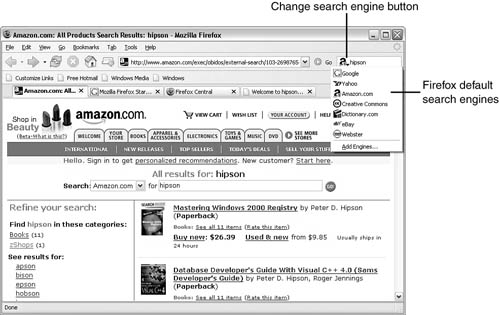
Figure 3.1. For many users, Firefox’s default group of search engines, displayed when you click the Change Engine button, is sufficient.
Amazon.com—. You might wonder why some of these are considered search engines. For example, Amazon is a bookseller. Searching on Amazon enables you to find books and other products it sells that match your search criteria. A good extension for Amazon is called MAB. With this extension, you get a greatly improved search capability.
Answers.com—. A search engine similar to Google. Answers.com has a toolbar for Firefox, and there is a supporting utility named 1-Click to allow the user to get information by pressing Alt and clicking text.
Creative Commons—. This is an innovative, nonprofit, alternative to traditional copyrights and can be found at http://creativecommons.org. Anything written, created (as in an artistic creation), and so on is protected automatically by a copyright. The author need do nothing and is always protected by international convention. This is an implied copyright, which allows the holder to enjoin (or prohibit) an infringer from using the copyrighted work. The holder cannot, however, recover damages with an implicit copyright. An artist (author, performer, and so forth) can also apply for an explicit copyright, which allows the holder to recover damages from an infringer in addition to preventing an infringer from copying his work.
eBay.com—. eBay is the largest, best-known online auction site on the Internet. (eBay says it’s not an auction house, but a place where people can auction items.) If you want to buy something, new, used, or whatever, you can probably find it on eBay. Of course, if you’re selling something, eBay offers an international audience of millions of potential buyers.
Firefox saves a history of searches, which can be cleared in the Saved Forms tab in the Privacy section of the Options dialog box. In addition, Firefox has a feature called Sanitize that clears certain information, such as history, forms, cache, and so on, when Firefox closes. Sanitize is available as a command in the Tools menu, in addition to being called when Firefox exits.
You are not limited to these search engines. You can add search engines to Firefox if you want. In Figure 3.1, you saw the built-in search engines preinstalled in Firefox. When you click the icon on the left of the Search bar, a drop-down lists the currently installed search engines. At the bottom of the list of installed search engines is an item named Add Engines.
Clicking Add Engines displays the web page shown in Figure 3.2. This page lists another eight search engines. At the bottom of that list is another link to find even more search engines.
Installing one of these search engines requires that you click the appropriate link. A prompting dialog box asks whether you want to add the selected search engine to the search bar. Click OK to add it; then check your installed search engines and the new one will be added to the list.
Mozilla’s top search engines to add on include
Wikipedia (www.wikipedia.org)
Dictionary.com (www.dictionary.com)
IMDb (www.imdb.com)
Astalavista (www.astalavista.com)
Altavista (www.altavista.com)
LEO (search.leo.org)
MSN (www.msn.com)
As Figure 3.3 shows, literally hundreds of search engines are available. Clicking a category displays a list of search engines—for example, clicking Classified(10) displays a list of 10 search engines you can install. You can then install as many of these as you want.

Figure 3.3. Each of the categories is followed with a number, the count of available search engines.
In addition to the search engine technology, there are some useful search extensions for Firefox. If you navigate to Mozilla’s Firefox extensions page and click Search in the extensions categories, you are presented with these extensions.
Tip
Although they’re easily added to Firefox, search engines are a bit more difficult to remove. To remove a search engine, go to Firefox’s installation folder and open the subfolder named searchplugins (for example, in Windows you would open C:Program FilesMozilla Firefoxsearchplugins). The searchplugins folder has two files for each search engine you have installed: the engine (.src) and an icon file (.png or .gif). Delete both files for the search engine you want to remove.
Firefox enables you to easily switch between search engines. For example, when first installed, Firefox uses Google to execute searches when the Search bar is used. To switch search engines, click the change search engine button at the left end of the Search bar (see Figure 3.4). This icon has a down arrow symbol to signify that this is a drop-down control.
When the Change Search Engine button is clicked, you can select any of the search engines listed (see Figure 3.4). (If the search engine you want is not listed, refer to the previous section.) Clicking a search engine makes it the new default for searches.
Firefox offers many unique tools and techniques. This is a direct result of a product that is not only driven by the users, but developed by them as well. One very powerful system in Firefox is the keywords capability.
With keywords, you can type a keyword in the Location bar and Firefox goes to the desired site and uses that site’s search to find the search terms. Configuring keywords is not difficult, but it’s not well documented. Let’s go through an example, step by step. Go to a site that has a search box. This site could be a search engine or any site that has an internal search capability.
Note
Keywords are not case sensitive, but you can define both upper- and lowercase keywords using the same characters. For example, you can create two keywords: HID and hid. I try to avoid confusion by always keeping my keywords lowercase—it is easier to type and being consistent helps me avoid any conflicts.
Navigate to the desired page (it must have a search edit box).
Right-click the search edit box on the page (see Figure 3.5). Don’t try to right-click Firefox’s Search bar.
In the Add Bookmark window, type a name for this bookmark and a keyword (see Figure 3.6). When done, click OK.
Use the keyword. In the Location bar, shown in Figure 3.7, type the keyword and a search term. The search term can be anything the site expects you to use.
If all goes well, you should be taken to the site’s search results (see Figure 3.8).
Now, if that isn’t the coolest trick, then nothing is.
Let’s face it, some web pages are so long that locating the term or word you are interested in on the page is like finding a needle in a haystack. Internet Explorer sports that painful, crude find text capability that is only slightly better than Notepad’s truly horrid find. Savvy Internet Explorer users have used Google’s toolbar to enhance finding items. With Google’s toolbar, you get a place to enter your search terms, a search button, and (on the right end) a set of dynamic search buttons—one for each term you type into the search terms box. You can search for one set of terms and type something else into the search terms box without doing a new Google search and have those dynamic buttons redefined.
Firefox does not have an official Google toolbar. Google is working on it, so there might be a Google-supplied Google toolbar by the time you read this. A Googlebar extension is available, though. It’s not developed by Google, but it’s a very good implementation. This Googlebar extension doesn’t have a pop-up blocker, however, because this functionality already exists in Firefox.
Firefox also has something that Internet Explorer lacks: a find toolbar. You can display the Find bar by either pressing Ctrl+F or selecting Edit, Find in the menu. The Find bar is located on the bottom of Firefox’s main window, as shown in Figure 3.9.
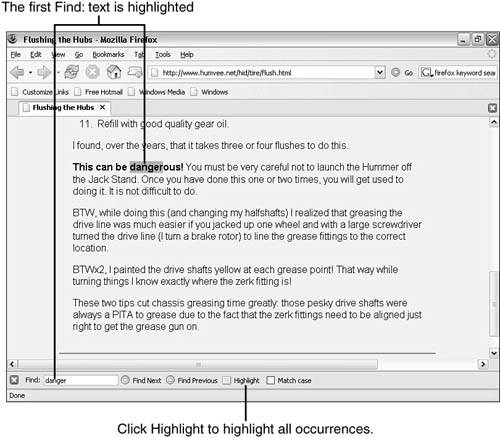
Figure 3.9. The Find bar lets you search for words on the current page. It can also highlight the term searched for.
Using the Find bar’s Find area, you can type a word(s). As you type, Firefox searches for what you type, finding and highlighting the first occurrence. As you type more letters, the search moves to the next match. For example, I typed h and Firefox found the first h it encountered. Then, I added another letter, making it hu, and Firefox found the first occurrence of these two letters. Adding more letters makes the search more precise.
Tip
Firefox’s Find bar can highlight all occurrences of the find text in the document if you click the Highlight All button.
If, at some point, you type something that is not on the current page, Firefox highlights what you are typing in red and at the right end of the Find bar displays the message Phrase not found to tell you that the word is not on the page.
Note
The Firefox Find bar—or, as it’s sometimes called, the Find toolbar—has a number of controls. From the left they include an area in which to type characters to look for, a Find Next button, a Find Previous button, a Highlight All button, a Match Case button, and a message area. Firefox always highlights the first occurrence of the term typed. Clicking the Highlight button tells Firefox to highlight all occurrences of the search term found on the page. Pressing F3 or clicking Find Next takes you to the next occurrence of the find text.
Sometimes after you perform a search, it would be nice to save the search results. There are many reasons for doing this, but for the sake of argument, let’s say you just finished a complex search and were then called away from your computer.
Using Firefox’s bookmarks, you can save a search by selecting Bookmarks, Bookmark This Page in Firefox’s menu. You are prompted for a name for the bookmark; you can either use the default (the search engine name with the search terms appended) or give the search a more meaningful name.
Figure 3.10 shows a Google search and the Add Bookmark window. The name, Google Search: hena-c shepard, is the default name for the search.
Each user has a history. Firefox keeps track of your history, where you’ve been, what you’ve done.
When you need it, Firefox puts the history in a window on the left side. It is able to display either history or bookmarks in what it calls a sidebar. This history list is well organized and useful in helping you return to a website or URL you looked at previously. For example, Figure 3.11 shows the history for my past browsing.
Along with the default date and site organization, you can select options to order your history by Site, Date, Most Visited, or Last Visited.
Date organization is arranged by days (Today, Yesterday, 6 Days Ago, and Older than 6 Days). History older than nine days is deleted by default, but you can set this in Tools, Options, Privacy tab (see Figure 3.12).
In addition to your history of pages visited, Firefox also maintains a history of files downloaded. Each time you download a file, Firefox gives you the option of either opening the file or saving it. Some file types, however, must be saved; in this case, the Open option is disabled.
Caution
Don’t confuse deleting a download from the Download Manager’s list with the Remove option. Deleting the file from the Download Manager leaves the file in the download location. Clicking Remove removes the file from the list and deletes it.
You can see which files have been downloaded by Firefox by selecting Tools, Downloads in Firefox’s menu. The Download Manager also displays when a download is in progress. You can also simply press Ctrl+J to display the Download Manager.
Firefox’s Options dialog box has a tab under Privacy named Download History. You can choose how Firefox removes items from the Download Manager’s list: Select Manually, Upon Successful Download, or When Firefox Exits. My preference is manually, the default action.
Tip
The Download Manager’s Clean Up button, shown in Figure 3.13, deletes download entries from the list. It does not delete these files from your drive! You must do this manually by clicking Remove for each file you want deleted.
Downloads, by default, are placed on your desktop by Firefox. I don’t like this convention—things on my desktop should be of a more permanent nature. I do have a location for downloads, though—a subfolder in the My Documents folder, called My Downloads. Under My Downloads I have created folders to allow me to easily organize my downloads.
The default download folder can be set in Firefox’s Options dialog box by setting the Downloads setting. You can specify a folder location or have Firefox prompt you for a location for each download by selecting Ask Me Where to Save Every File.
I’ve found that some downloaded files have sensible filenames but that some do not. By creating subfolders in My Downloads, you can easily determine what any cryptically named files are for.
Sadly, Firefox doesn’t allow you to dynamically create or specify locations for a given download. This can be one of the things about Firefox that you fix when you start customizing.
Here are a few ideas from the experts:
Use more than one search engine. Each search engine specializes in its own way and can return vastly different results.
For common searches, save the search as a bookmark. This saves having to type the search terms.
Site-based searches can be done quickly from the Location bar. Just type a term and press Enter. Firefox tries to find the site that most closely matches the term.
With Firefox, you can have more than one favorite search engine. Just add more search engines to the Search bar.
Switching search engines is easily done using the Search Engine drop-down button on the Search bar. Display the list and click the desired search engine.
Keywords enable Firefox users to create searches for sites that have a search capability but are not search sites.
The Find bar enables you to search the current page for a term. The search starts as soon as you begin to type the search term. Optionally, you can highlight all occurrences of the term.
Firefox’s History sidebar enables you to return to a site that you recently visited. Sites can be organized by date, name, and popularity.
Firefox keeps a history of all files it has downloaded. This history can be cleared as desired. Select the download in the Download Manager and press Delete. An option exists that tells the Download Manager to remove a download from the list after a successful download.

